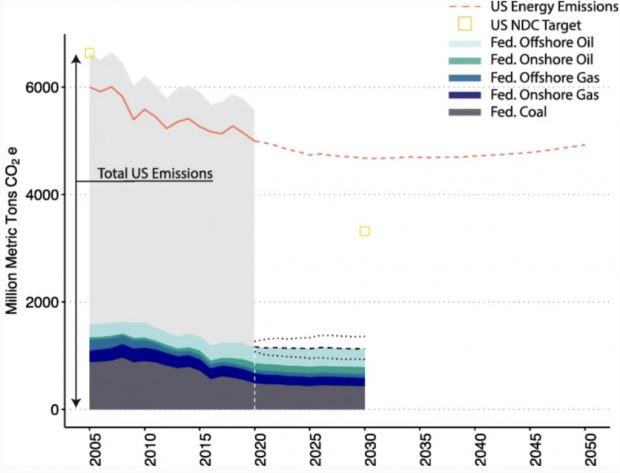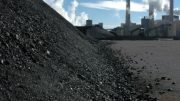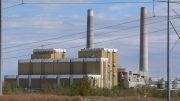Emissions equivalent to nearly a quarter of the US total since 2005 have come from fossil fuels extracted on the nation’s public lands and waters, according to recent analysis.
The study, published in Climatic Change, assesses the volumes of greenhouse gases generated by extracting and burning coal, oil and natural gas from regions owned by the federal government.
It also estimates how much this will change over the next decade, concluding that “minimal” reductions to these emissions are expected by 2030, the date by which the US has committed to cutting its emissions to 50-52% below 2005 levels.
This analysis was conducted before the Biden administration’s latest announcement that it will open up new federal lands to drilling amid growing pressure to address rising fuel costs.
The study’s lead author tells Carbon Brief that unless the government introduces new policies such as a carbon fee added to these fossil fuels, emissions from this sector could remain high long into the future.
Federal emissions
The study assesses the “lifecycle” emissions from coal, oil and natural gas produced on US federal lands and waters between 2005 and 2019. This includes everything from methane leaking out of pipelines to carbon dioxide (CO2) from burning coal.
On average, these emissions amounted to 1,408m tonnes of CO2 equivalent (MtCO2e) per year – equivalent to around 23% of domestic US emissions across this 15-year period.
Study author Laura Zachary, an energy analyst at Apogee Economics and Policy tells Carbon Brief that this includes both fuels that are used in the US and those that are exported abroad – although previous research has shown that only 4% of the lifecycle emissions are produced outside the US. Only domestic emissions count towards the nation’s climate goals.
These values were calculated using data on production and consumption of fossil fuels available from the US Environmental Protection Agency (EPA), the US Energy Information Administration (EIA) and the US Office of Natural Resources Revenue (ONRR).
The researchers then used a combination of EIA’s projections and a machine-learning approach that enabled them to forecast future trends for coal, oil and gas production across public lands and waters, and work out how much emissions they would generate.
As the coloured area of the chart below shows, emissions from these fossil fuels have fallen since 2005, mainly due to a decline in coal use, which is shown in dark grey. (The light grey area in the chart indicates total historical US emissions, for comparison, while the red line shows emissions from the energy sector alone.)
Most of this drop took place between 2010 and 2016 when gas rapidly replaced a lot of coal in the US power sector.

Emissions associated with the extraction and combustion of fossil fuels from US federal lands and waters (green, blue and dark grey area), including central projections out to 2030 (high and low projections indicated by black dotted lines). Total historical US emissions are shown in light grey, the solid red line indicates historical US energy emissions and the dotted red line shows the Energy Information Administration’s projections through 2050. Gold squares depict the 2005 reference point and the 2030 target of the US nationally determined contribution (NDC) emissions target. Source: Ratledge et al (2022).
Since then, emissions from this sector have been fairly stable. The study’s modelling, shown by the dotted lines in the chart above, predicts “minimal additional emissions reductions stemming from fuels produced on federal lands and waters”. The findings suggest they will fall by just 6% between 2019 and 2030.
The researchers conclude that given the “aggressiveness” of the Biden administration’s upcoming climate target – a 50-52% reduction in domestic emissions by 2030, compared to 2005 – the government “should consider how policies directed at federal lands and waters fit into their broader climate strategy”.
‘Meaningful reductions’
An argument frequently advanced in favour of drilling on public lands is that stopping it would simply shift extraction to other areas.
The paper argues that, on the contrary, reducing federal activities would drive “meaningful emissions reductions even after accounting for partial shifts in production to non-federal lands”. Dr Brian Prest, an economist at thinktank Resources for the Future, who was not involved in the study, explains to Carbon Brief:
“It’s textbook economics. Reducing the supply of a product reduces the amount of that product ultimately consumed…Shifting production – or what economists call “leakage” – partially offsets the direct effect, but the offset is not one-for-one.”
This has been supported by a federal court ruling as well as research. For example, a 2018 paper suggested that a ban on new and renewed fossil fuel leases on US public lands and waters could cut global CO2 emissions by 280MtCO2 annually by 2030, equivalent to around 5% of US emissions.
Dr Peter Erickson, climate policy programme director at Stockholm Environment Institute US, who authored that study, tells Carbon Brief that despite these results – and the likes of the International Energy Agency (IEA) suggesting no new oil or gas fields are needed to limit warming to 1.5C – such scenarios rely primarily on reductions in demand.
As such, he says the relatively small dip expected in US federal fossil-fuel emissions “doesn’t necessarily indicate that federal lands policy is incompatible with ambitious climate goals”.
Nevertheless, he notes that the sheer scale of fossil fuels contained in US federal lands means targeting their supply could still make good climate policy.
New policies
Joe Biden has had a complicated relationship with fossil fuels since becoming president in 2021, following a campaign in which he pledged to end all oil-and-gas drilling on public lands. It has been further complicated by the war in Ukraine and resulting spikes in fuel prices.
The most recent development was an announcement that more than 140,000 acres of public lands would be opened up to oil-and-gas leasing, a move that many viewed as violating Biden’s campaign pledge and hampering US climate targets.
The administration distanced itself from the action, with officials emphasising that they were acting in response to a court decision that forced them to restart drilling, against the president’s policy.
Nathan Ratledge, a PhD student and fellow at Stanford University who led the new study, tells Carbon Brief that it would be difficult to estimate the impact of new leases on emissions in 2030 and beyond, noting that drilling may not start for years.
Nevertheless, he says that “our emissions profile could stay higher beyond 2040 if [fuel] prices stay high and we don’t pass any policy”.
As it stands, the researchers say fossil fuels from federal lands are very cheap as they are “effectively subsidised” with low leasing and production fees.
In announcing the new round of leases, the Biden administration said it would raise royalty rates paid by fossil fuel companies to the federal government – a move that has the potential to cut emissions.
Ratledge notes that on top of this a carbon fee applied to fossil fuels from federal lands would be a “no-brainer”.
Such policies are particularly relevant as fossil fuels on federal lands can largely be regulated without the approval of Congress – something that has hindered recent attempts to pass US climate legislation.
Jamie Pleune, an associate professor of environmental law at the University of Utah tells Carbon Brief the study is “valuable and insightful”, noting that the predicted drop in federal fossil fuel emissions “could be much better”. She says:
“The federal government has the ability to implement policies that would achieve greater emission reductions, including imposing a net-zero emission requirement on all new oil and gas development. This could be achieved using existing legal tools, available crediting methodologies, and without waiting for Congressional action.”
However, experts note that given the global nature of fossil fuel markets, much of the emissions savings from limiting US production would occur in foreign countries due to the impact on oil prices. Prest tells Carbon Brief:
“The climate doesn’t care about accounting, of course, but this makes it difficult to relate the potential emissions reductions from federal lands policy to those US targets.”
Data missing
The researchers say they are filling a gap as the US government has “neglected to track emissions [from fossil fuels on federal lands] in a comprehensive manner”.
An exception came with a US Geological Survey (USGS) report released in 2018, commissioned by the Obama administration two years earlier with the intention of creating an “annually updated database”. However, the data has not been updated since Donald Trump took over the presidency the following year.
The new analysis builds on the USGS work, using more up-to-date figures and extending the estimates out to 2030. According to the study authors, these figures are important for US climate policy. “Simply put – we typically don’t regulate what we don’t measure,” Ratledge tells Carbon Brief.
April 21, 2022
Originally published by Carbon Brief under a CC license





